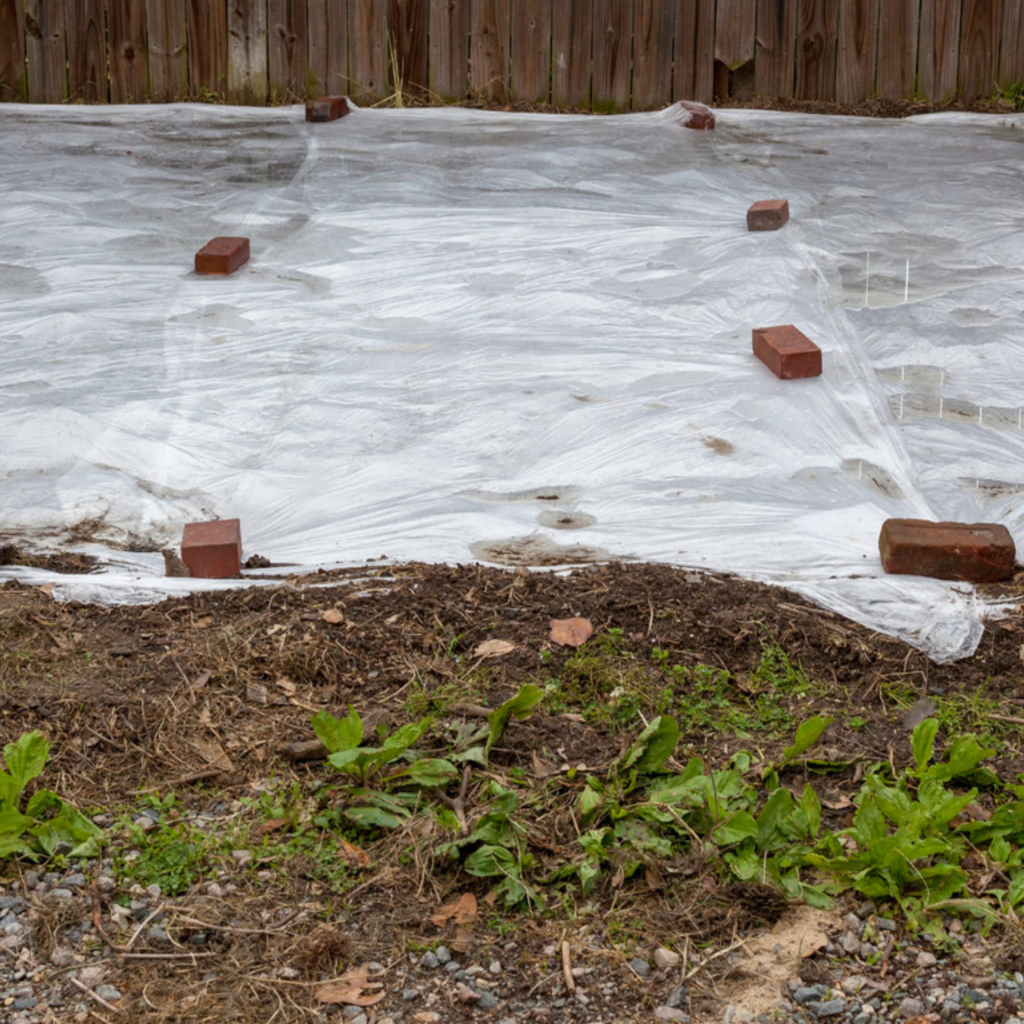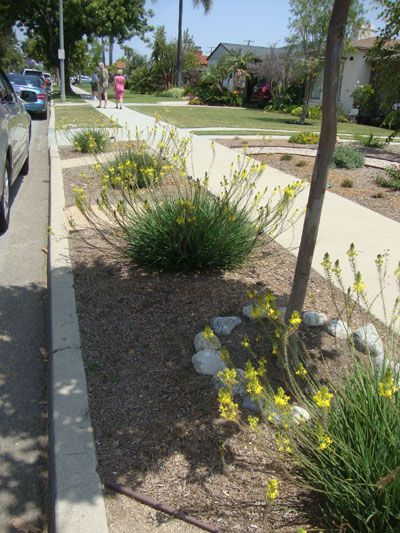.png)
WaterWise Landscape is a landscape or garden that uses techniques to reduce or end the need for extra watering. This includes:
- Adding compost and/or mulch to keep soil moist and prevent water loss from evaporation.
- Changing irrigation heads to drip or low-flow nozzles.
- Planting native or adaptive plants with lower water needs
WaterWise Landscape saves water:
Water savings depend on your watering habits, existing turf, and site conditions. Typically, turf needs 1 inch of water weekly in summer, while mature native beds may require only ½ to ¾ inch every other week. For instance, converting a 500 sq. ft. turf area, which requires 1,240 gallons monthly, to a WaterWise landscape could save up to 930 gallons monthly.
Learn more about WaterWise Landscaping rebates, requirements, and it's details below:
- What does "75% healthy turf" mean and why is it required?
-
This program assists customers in maintaining a healthy and attractive landscape while reducing water usage. If you're not regularly watering your yard, this program may not help you save water. For eligibility, at least 75% of the conversion area should have healthy turf grass; dead lawns won't qualify. Austin Water may evaluate thinning or dormant grass during seasonal changes, possibly requiring a site visit for verification.
Healthy Lawn

Lawn Needing Pre-inspection

Lawn That Will Not Qualify

- What if I already started work?
-
Any work started before getting approval from Austin Water will not qualify. This helps us to be sure that we offer rebates to landscapes with the greatest potential to save water.
- When will I receive my rebate?
-
You should receive it within 6-8 weeks of project completion. We do not issue checks before October 1st (for fall installations) regardless of completion date.
- How do I remove turf grass and what should I do afterwards?
-
To prevent grass from regrowing, consider these options:
- Use sod cutters to remove it below its roots
- Utilize a tiller to break it into clumps
- Smother it with newspaper/cardboard
- Solarize it.
Your choice depends on budget and effort. Next, till the plant bed area down 6 inches, adding compost-amended soil for nutrients and water retention. For gravel or plain mulch beds, residential customers must apply weed barrier fabric over the soil before adding hardscape.
- What is solarization?
-
Solarization uses the heat of the soil and sun to bake grass and weeds. To solarize an area, water it well, cover with clear, thick plastic, and weigh down the edges of the plastic. The grass beneath it will sunburn and die.

- What about Bermuda Grass? It keeps coming back!
-
Removing Bermuda grass can be challenging. The most effective approach is to kill it using one of the methods mentioned earlier. Once the grass is dead, dig it out and till the area to remove as much of the blade and root as possible. Wait a few weeks to identify any regrowth and repeat the process as needed. After the second or third treatment, all the grass should be eliminated. Adding a layer of mulch over the area will help prevent grass from returning in the future.
- Why do I have to make changes to my automatic sprinkler system?
-
Spray heads that water turf grass are inefficient for watering native plants. If you do not plan to cap off irrigation in the converted area, we recommend changing it to drip. Check our water restrictions page for irrigation guidelines.
- Why do I have to till the soil and add 1 inch of compost to my plant beds outside the drip line of trees?
-
Tilling the soil with compost helps keep water in the root zone of your plant beds. This is a benefit we need for our harsh dry summers. For every 1% of organic matter content, each cubic foot of soil can hold an additional 1.5 quarts of plant-available water.
- May I install mulch beds at any time or do I have to wait for the installation period?
-
You may begin installing the mulch hardscape portions after Austin Water approves your conversion. You may only install plant material during the spring and fall installation windows.
- Why do I have to wait for the Fall or Spring to install plants?
-
Plants go through a lot of stress during installation. Intense summer heat and dry conditions make it a struggle to keep them healthy. In spring and fall, evaporation rates are lower and we receive more rainfall.
- What should I plant in the Fall vs. the Spring?
-
Fall is ideal for planting trees, shrubs, cacti, succulents, and many perennials, promoting root growth over winter for a head start in spring. Spring is perfect for flowering perennials, having undergone one winter dormancy at the nursery for quicker establishment. Complete your landscape by the deadline in either season to allow for establishment before winter freezes or summer heat. Choose plants carefully and employ proper planting techniques for optimal growth. For more details, visit Grow Green.
- Can I use native plants that are not listed in the Grow Green Guide?
-
Other native or adaptive plants can thrive here beyond those listed in the Grow Green Plant Guide. If you have specific plants in mind, include a list with your application or contact us to see if they qualify.
- What does "Over 50% plant cover" mean?
-
This indicates that once plants reach mature size, they will cover over half of the conversion area, reducing erosion and mitigating the heat island effect of urban living. To determine plant cover, use the mature spread of the plant (found on its information tag) and convert it to square feet. Then, incorporate this square foot coverage into your landscaping plan.
- Can I put gravel in the converted area?
-
Residential customers can incorporate a gravel path (up to 3 feet wide) in the converted area, with weed barrier fabric underneath to prevent weed or grass growth. Ensure irrigation heads are adjusted to avoid spraying the path. A gravel or stone patio area of up to 200 square feet is also permissible. However, multi-family Homeowners Association applicants are not permitted to use gravel or stone in the conversion area.
- Do I need to install edging?
-
Edging is not required; but it is great for weed control as well as providing a sense of permanence to a planter bed. Many different materials and methods are available. A simple 6-inch wide shallow trench or some stones are low cost and effective ways to edge your garden.
- Can I install a water feature in the converted area?
-
No water features are allowed within the conversion area.
- Can I install artificial turf or permeable concrete?
-
These items are not eligible for the rebate.
- Can I convert the area between the sidewalk and street?
-
Residential customers may convert this area. But, know that this is often a public Right of Way and/or a Utility Easement. If official work occurs in this area, landscaping repairs will be at homeowner expense. For pedestrian safety, please use plants without thorns or spikes. Multi-family Homeowners Association applicants may not do any conversions in the right-of-way.

- Can I convert the St. Augustine to a more drought tolerant grass?
-
Buffalo, Bermuda, and Zoysia grasses exhibit greater drought tolerance compared to most St. Augustine varieties. However, water savings from converting to these grass types are inconsistent. People tend to overwater these grasses during their dormant periods to maintain greenness. We will monitor new turf varieties and pilot study outcomes to potentially incorporate "drought-tolerant" turf into the program in the future.

